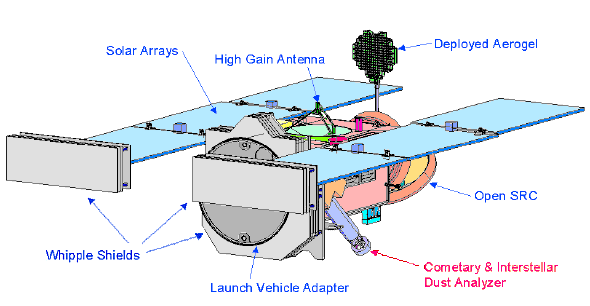

The purpose of the Cometary and Interstellar Dust Analyzer (CIDA) instrument is to intercept and perform real-time compositional analysis of dust as it is encountered by the spacecraft for transmission back to Earth.
The CIDA instrument is a mass spectrometer, which separates ions' masses by comparing differences in their flight times. The operating principle of the instrument is the following: when a dust particle hits the target of the instrument, ions are extracted from it by the electrostatic grid. Depending on the polarity of the target positive or negative ions can be extracted. The extracted ions move through the instrument, are reflected in the reflector, and detected in the detector. Heavier ions take more time to travel through the instrument than lighter ones, so the flight times of the ions are then used to calculate their masses.

The CIDA is the same instrument design as flew on Giotto and two Vega spacecraft where it obtained unique data on the chemical composition of individual particulates in Halley's coma. It consists of an inlet, a target, an ion extractor, a time-of-flight (TOF) mass spectrometer (MS) and an ion detector. The inlet is a baffled system to prevent sunlight from entering the instrument and raising the background noise in the detector. The target is planned to be a corrugated Ag or other heavy metal material. It will not be necessary to have a moving Ag foil for the Wild flyby, as was done for the higher flux at Halley. In addition, the target area will be increased to 50 cm2 from the previous 5 cm2. A light flash which accompanies the initial impact is detected and used to set the zero for the TOF measurement. Electrostatic grids extract positive or negative ions, depending upon which polarity they are commanded to, from the impact microplasma. These ions move down a bent-tube TOF MS, with an electrostatic reflector to focus ions of similar energies onto the ion detector. By measuring arrival time, the mass of the ions is determined. It is expected that at the 6.1 km/s flyby speed, molecular ions as well as atomic ions will be important. The instrument is sensitive at least over the range AMU=1 to 150. Even sub-micron sized particles produce observable signals and compositional profiles.
The use of a transient recorder mode will allow a much superior data set than was possible from the data-constrained links that were available for the previous PIA flights because it will take all data at the equivalent of Mode 0 data, i.e., the highest time resolution and full peak profiles rather than peak detection. In addition, it will eliminate the criticality of the event detection methods since all signals generated by the ion detector itself will be accepted rather than gated. For the comet flyby, most of this data will be played back slowly over ensuing days or weeks.
The co-investigator in charge of the CIDA is Jochen Kissel of Max-Planck-Institut f. extraterrestrische Physik in Garching, Germany where the instrument has been developed. Electronics hardware has been built by von Hoerner & Sulger GmbH in Schwetzingen, Germany. Software for the CIDA instrument is being developed by The Finnish Meterological Institute.
Cometary and Interstellar Dust Analyzer instrument is located on the
underside of the STARDUST spacecraft
as shown in the picture below.
